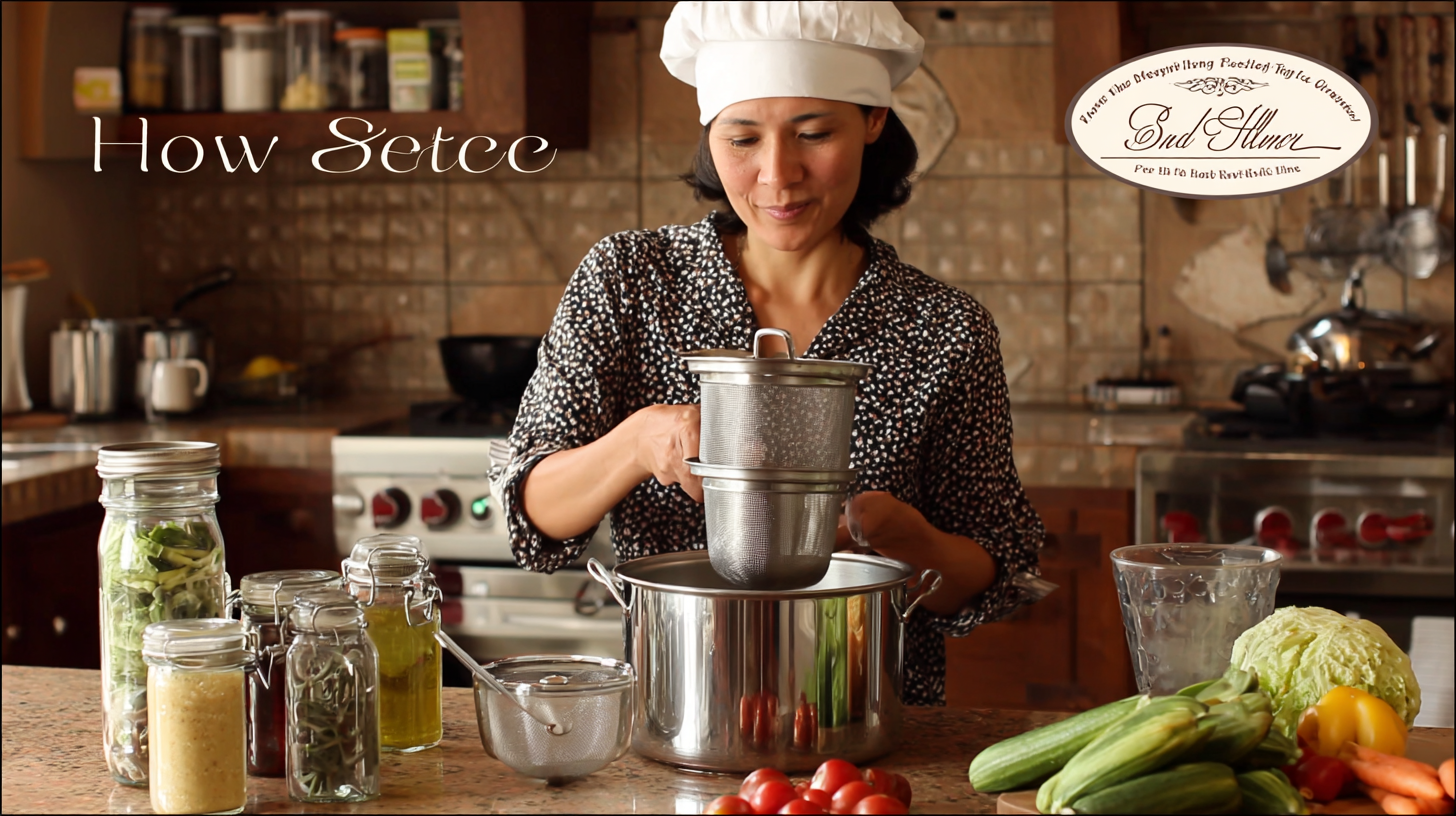Welcome to this website!

In the world of culinary arts, the choice of the right tools can significantly impact efficiency and quality in food preparation. A critical yet often overlooked tool in many kitchens is the food strainer, which plays an essential role in various cooking processes, from pureeing vegetables to draining pasta and preparing sauces. According to a recent market analysis by Grand View Research, the global kitchenware market is projected to reach USD 41.7 billion by 2027, indicating a growing demand for specialized cooking tools like food strainers. This highlights the importance of quality and design, particularly in the context of "Made in China" products that dominate the export market. Choosing the best food strainer not only enhances your culinary capabilities but also ensures that you are investing in equipment that meets both local and international standards of quality and performance. By understanding the different types of food strainers available and their specific applications, you can streamline your cooking processes and elevate your culinary experience.

When it comes to selecting the right food strainer, understanding the various types available and their specific uses is crucial to enhance your culinary efficiency. The most common types include fine mesh strainers, colanders, and sieve strainers. Fine mesh strainers excel at filtering out tiny particles, making them perfect for tasks like sieving flour or straining sauces, ensuring a smooth texture in your dishes. Colanders, with their larger holes, are ideal for draining pasta or rinsing fruits and vegetables, allowing water to flow quickly while retaining solid ingredients.
Another option is the sieve strainer, which comes in different mesh sizes to accommodate a variety of cooking needs. A coarse sieve is perfect for straining soups or stocks, while a finer sieve serves well for delicate tasks like filtering juice or custards. Additionally, specialized strainers, such as chinois or conical sieves, can be used for more intricate culinary techniques, offering versatility in gourmet cooking. By understanding these different food strainers and their specific applications, you can choose the right tool for your needs, ultimately making your cooking process more seamless and enjoyable.

When it comes to choosing the best food strainer for your culinary needs, several key factors should be considered to ensure that you make an informed decision. First, consider the material of the strainer. Stainless steel strainers are often favored for their durability and resistance to rust, making them ideal for long-term use. According to a 2021 report from the Food Service Equipment & Supplies Association, over 60% of professional chefs prefer stainless steel tools due to their longevity and ease of cleaning.
Another vital consideration is the size and design of the strainer. You should select a size that fits your typical cooking volume. A strainer that is too small can lead to spills and inefficiency, while one that is excessively large may prove cumbersome. Ergonomics also play an essential role; a good strainer should have comfortable handles and be easy to maneuver, reducing the risk of strain during use.
**Tips:** When selecting a food strainer, look for one with a fine mesh for thorough straining of liquids and solids. Additionally, consider a strainer with a heat-resistant handle, which is particularly useful for handling hot foods. Don't forget to assess the strainer's ability to fit over various bowls or pots, as versatility can enhance your kitchen efficiency significantly.
| Feature | Description | Considerations |
|---|---|---|
| Material | Stainless steel, plastic, silicone, or mesh | Choose material based on durability and ease of cleaning. |
| Size | Available in various sizes to accommodate different batch sizes | Pick a size that suits your cooking volume. |
| Mesh Size | Fine, medium, or coarse mesh options | Select mesh size according to the type of food being strained. |
| Handle Design | Ergonomic and easy to grip handle | Look for a handle that provides comfort during use. |
| Versatility | Can be used for various tasks, such as rinsing and draining | Consider a strainer that can multitask for increased utility. |
| Ease of Cleaning | Dishwasher safe or easy to hand wash | Select a design that simplifies cleanup. |
| Price | Range of prices depending on features and quality | Set a budget while considering functionality and durability. |
When selecting a food strainer, material durability plays a crucial role in ensuring both longevity and efficiency in the kitchen. Stainless steel strainers are often favored for their resilience and resistance to rust and corrosion. They can withstand high temperatures and maintain structural integrity even under heavy use, making them ideal for both draining pasta and straining stocks. Meanwhile, silicone strainers offer flexibility and ease of use, but they may not provide the same level of durability in the long term, particularly when exposed to sharp objects or high heat.
Efficiency is another important consideration when choosing a food strainer. Mesh strainers with fine holes are perfect for achieving a smooth consistency in sauces or for rinsing grains, while colanders with larger holes are designed for quick draining of larger items, such as fruits and vegetables. An efficient strainer should not only perform its function well but also be easy to clean and store, so opting for a design that fits comfortably in your kitchen setup can further enhance your culinary workflow. Balancing material durability with practical efficiency will help you select the right strainer for your specific cooking needs, ultimately saving time and effort in meal preparation.
When it comes to cooking, the right tools can make all the difference, especially when it comes to food strainers. A good food strainer can significantly reduce the time and effort needed to achieve the perfect consistency in your dishes. Whether you are making sauces, pureeing fruits, or straining vegetables, selecting a high-quality strainer tailored to your culinary needs will streamline your cooking process and enhance your efficiency in the kitchen.
One of the essential tips to consider when choosing a food strainer is the size. Opt for a strainer that is large enough to handle your typical batch size but not so cumbersome that it's a hassle to clean or store. Moreover, consider the material of the strainer; stainless steel is often the best choice for durability and ease of cleaning. A fine mesh strainer can be particularly useful for achieving smooth textures, while a colander is excellent for draining pasta or rinsing beans efficiently.
Another key aspect to think about is the type of handle and stability. A comfortable grip can prevent accidents and make lifting heavier loads a breeze. Look for strainers with non-slip bases or hooks to secure them over bowls or pots, freeing up your hands for other tasks. Employing these strategic choices in your kitchen will not only save you time but also elevate your cooking experience.
When it comes to selecting a food strainer, quality is paramount. Top brands such as OXO, Cuisinart, and stainless steel options from FineDine are renowned for their durability and performance. OXO strainers are particularly prized for their ergonomic design and ease of use, making them a favorite among home cooks. Cuisinart, on the other hand, offers versatile strainers that come in various sizes, perfect for both small and large batch preparations. For those who prefer an eco-friendly approach, FineDine's stainless steel strainers are not only durable but also easy to clean.
In addition to brand reputation, it's essential to consider the type of food strainer that best suits your culinary needs. For instance, a fine-mesh strainer is perfect for achieving silky smooth sauces or rinsing grains, while a colander is ideal for draining pasta. If you're frequently working with hot ingredients, opt for a strainer with heat-resistant materials. Ultimately, choosing the right food strainer can significantly enhance your cooking efficiency, streamline meal prep, and elevate your culinary creations.

